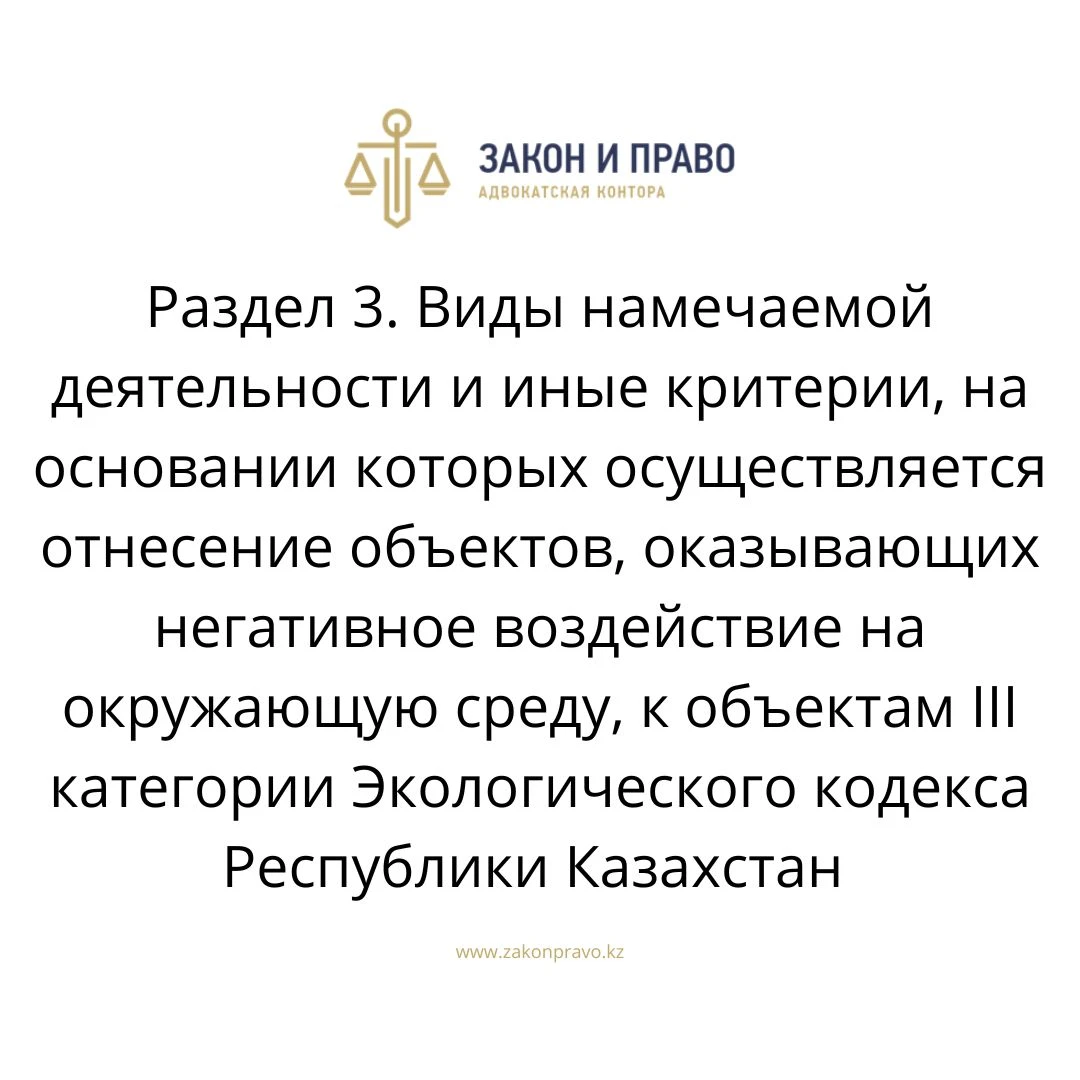Section 3. Types of planned activities and other criteria on the basis of which objects having a negative impact on the environment are classified as objects of Category III of the Environmental Code of the Republic of Kazakhstan
1. Types of activities and facilities:
1) production of flour mixtures;
2) production of fluoroplastics processing;
3) production of paper from finished pulp and rags;
4) Glycerin production;
5) production of galalite and other protein plastics (aminoplasts and others);
6) production of enamels based on condensation resins;
7) Soap production;
8) salt and salt milling production;
9) production of pharmaceutical potassium salts (chloride, sulphate, potash);
10) production of natural mineral paints (chalk, ochre and others);
11) production of tanning extract;
12) production of printing inks;
13) photochemical production (photographic paper, photographic plates, photographic and film films);
14) production of household chemicals from finished raw materials and warehouses for their storage;
15) drying oil production;
16) production of medical glass (without the use of mercury);
17) plastics processing industry (casting, extrusion, pressing, vacuum forming);
18) production of polyurethane;
19) production of ready-made dosage forms (without the manufacture of components);
20) production of paper from waste paper;
21) dry cleaning factories with a capacity of over 160 kg per day;
22) manufacture of plastic and synthetic resin products (mechanical processing);
23) production of carbon dioxide and dry ice;
24) production of artificial pearls;
25) manufacture of matches;
26) manufacture of leaded or rubber-insulated cables;
27) workshops for the repair of road vehicles, cars, bodies, rolling stock of railway transport and the subway;
28) production of metal electrodes;
29) Font foundry (lead-free);
30) printing production;
31) Offset printing factories;
32) printing plants using lead in production;
33) assembly of locomotives and electric locomotives;
34) production of clay products;
35) glassblowing, mirror production, glass grinding and etching;
36) mechanical processing of marble;
37) production of concrete and concrete products;
38) production of cooperage products from finished riveting;
39) matting and weaving production;
40) production of wood preservation with saline and aqueous solutions (without arsenic salts), dust jacket;
41) shipyards for the manufacture of wooden vessels (boats, boats);
42) carpentry, furniture, parquet, box objects;
43) cotonine production;
44) cocoon brewing and silk-winding production;
45) melange production;
46) enterprises of foam-jute twisting, rope, twine, rope and end processing;
47) production of artificial doodle;
48) shoe manufacturing;
49) production of yarn and fabrics from cotton, linen, wool in the absence of dyeing and bleaching workshops;
50) manufacture of knitwear and lace;
51) carpet production;
52) manufacture of shoe cardboard on leather and leather-cellulose fiber without the use of solvents;
53) bobbin and coil production;
54) wallpaper production;
55) manufacture of leather goods;
56) manufacture of bristle and hair brushes;
57) felting production;
58) confectionery production with a capacity of more than 3 tons per day;
59) sugar refining production;
60) production of pasta (with a capacity of more than 1 ton per day);
61) bakeries and bakery production (with a capacity of more than 3 tons per day);
62) industrial installations for low-temperature food storage with a capacity of more than 600 tons;
63) Grape juice plants;
64) fruit and vegetable juice and soft drink factories;
65) mills with a capacity of 0.5 to 2 tons per hour;
66) low-capacity facilities (mini-production): for processing meat, milk – up to 3 tons per day, fish – up to 3 tons per day;
67) reclamation facilities using livestock effluents;
68) livestock farms:
for the rearing and breeding of pigs from 100 heads or more (sows from 10 heads or more);
for cattle breeding from 150 heads and more;
for breeding poultry from 500 heads or more;
for breeding horses of 150 heads or more;
camel breeding from 150 heads and more;
for breeding sheep and goats from 600 heads and more;
animal farms – from 100 heads or more;
69) car maintenance facilities (passenger cars, except those owned by citizens; buses, except buses of urban transport);
70) trolleybus and tram fleets;
71) veterinary clinics with animal care, vivariums, kennels, dog training centers, animal overexposure points;
72) gas stations for refueling vehicles with liquid and gas motor fuel;
73) wastewater disposal facilities for filtration fields, terrain, and underground horizons with a discharge volume of more than 5,000 m3 per day;
74) storm water treatment facilities;
75) warehouses and open grain unloading sites;
76) warehouses and open places for unloading table salt;
77) transport and technical schemes for transshipment and storage of apatite concentrate of phosphorous flour, cement and other dusty cargoes transported in bulk, using warehouse elevators and pneumatic transport or other installations and storages that exclude dust removal to the external environment;
78) open warehouses and places for transshipment of moistened mineral construction materials (sand, gravel, crushed stone, stone, etc.);
79) storage areas and places for transshipment of pressed cake, hay, straw, tobacco products and others.
2. Other criteria.
Carrying out any type of activity that meets one or more of the following criteria:
1) the presence of stationary sources of emissions at the facility, the mass of pollutants in atmospheric emissions of which is 10 tons per year or more;
2) the use of facilities at the facility to provide electric energy, gas and steam using equipment with a design thermal capacity of 2 Gcal/hour or more;
3) accumulation of 10 tons or more of non-hazardous waste and (or) 1 ton or more of hazardous waste at the facility.
Notes.
1. In this section, production is understood as entrepreneurial activity for the serial production of goods, works and (or) the provision of services. The provisions of this section do not apply to the production of goods, works and (or) the provision of services by individuals for personal household purposes and to small businesses, including microenterprises engaged in the production of goods, works and (or) the provision of services on a one-time basis or in a small volume on individual orders with a predominant proportion of manual labor.
2. If the types or objects of activity in sections 2 and 3 of this annex coincide, section 3 includes the types and objects of activity that have quantitative indicators characterizing them below the thresholds specified in section 2 of this annex.
President
Republic of Kazakhstan
© 2012. RSE na PHB "Institute of Legislation and Legal Information of the Republic of Kazakhstan" of the Ministry of Justice of the Republic of Kazakhstan
Constitution Law Code Standard Decree Order Decision Resolution Lawyer Almaty Lawyer Legal service Legal advice Civil Criminal Administrative cases Disputes Defense Arbitration Law Company Kazakhstan Law Firm Court Cases


